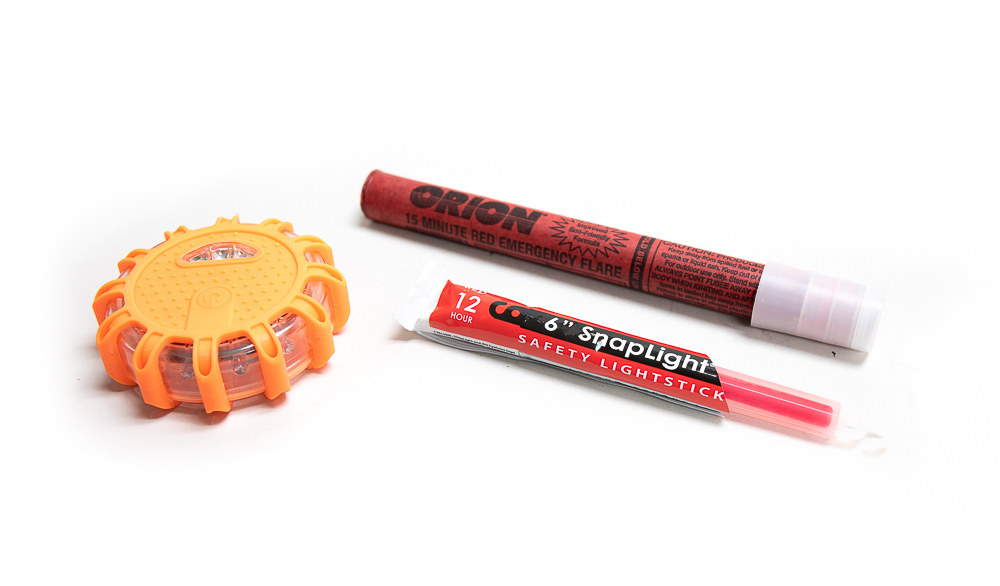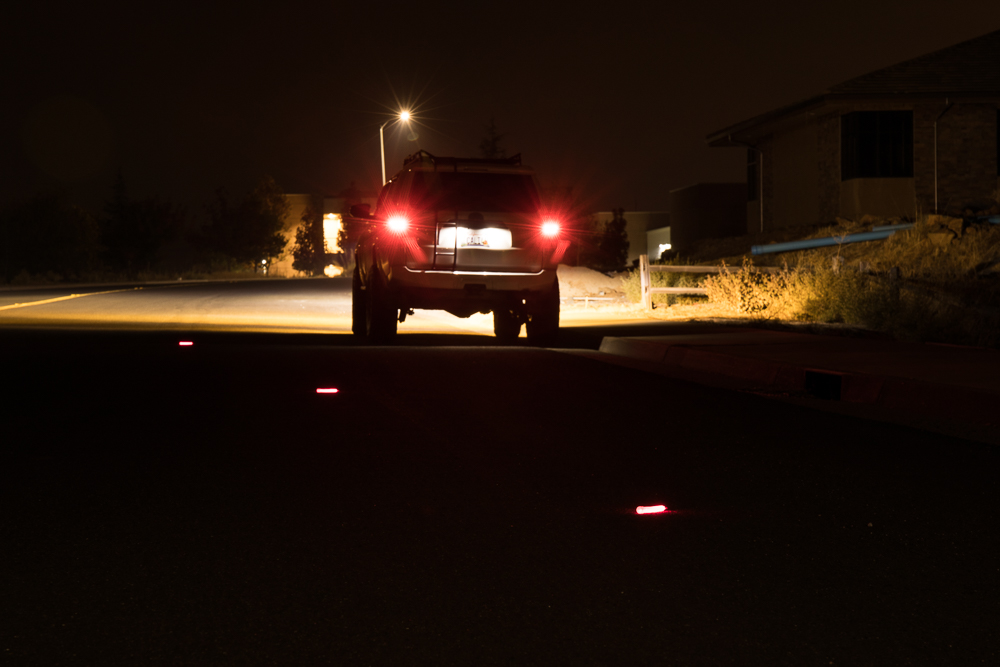LED Beacons, Light Sticks or Pyrotechnic Flares?

LED Road Beacons or Fire Flares. Has LED taken over the Traditional Flare Market?
When we prepare, most of what we do includes the thought of other drivers; jumper cables, winch, emergency lighting, you name it.
Not every other truck on the road is going to carry a set of road beacons or flares so you may want to consider it. Can you imagine giving someone a jump on the side of the road, in the middle of the night as a car is speeding around the corner and BAMM, slams into you?
Its similar to jumper cables, you may never use them for yourself but that one time you save someone’s ass, you will feel pretty damn good about it. Flares and road beacons are one of those tools we typically forget about when we are building our EDC recovery and tool bag.
Why Road Flares or Light Beacons?
When you come upon an accident or a stranded vehicle one of the first things you might notice is a road flare to warn you of the accident and to slow down.
The purpose of a road flare is simple, light up the surrounding area to warn of possible danger and to prevent any further accidents or injuries. But the type of road flare you use can be just as important as the road flare itself.
There are a few types of road flares that we are going to look at, the traditional pyrotechnic, the chemical light stick, reflective triangles, and the LED road flare emergency disc. We will go over the pros and cons of each to help you decide which is the best for you.
LED Emergency Beacons Vs. Pyrotechnic Flares

For emergency situations, most LED light applications have replaced Incendiary (inˈsendēˌerē)/pyrotechnic flares. Many companies, along with the USCG have performed studies where the LEDs have met or exceeded the expectations of the traditional flare.
LED lights eliminate the potential of fire-starting combustion flares that plague our highways and roadways. There are many benefits to LEDs over the traditional flares, however, not just fire-prevention. We wanted to point out a few differences and why you may want to consider LEDs over flame-based flares.
Options for LED Road Flares?
- Pyrotechnic: Check Price
- Chemical light stick: Check Price
- Reflective triangles
- LED road flare beacons: Check Price
Incendiary/Pyrotechnic

The traditional pyrotechnic road flare produces very bright light, is self-contained and dissipates as they burn. They work in many weather conditions such as rain, snow, and fog and costs very little.
But there is a downside to using the pyrotechnic road flares. They put off heat, which under dry conditions or leaking fluids from your vehicle, can lead to even more danger. Any flare that operates at a high heat should be used with caution.
Other drawbacks are that they can only be used once.
Pyrotechnic road flares also rely on chemical combustion, emit fumes that can be toxic if inhaled, and are toxic to the environment. The leave behind a white substance after being burned that pollutes the environment. I snapped this shot below, the next day after lighting the flare.

The ingredients are varied, but often based on strontium nitrate, potassium nitrate, orpotassium perchlorate and mixed with a fuel such as charcoal, sulfur, sawdust, aluminium, magnesium, or a suitable polymeric resin. Credit Wiki.

Pros
- Pyrotechnic: Check Price
- Bright intense light
- Self-contained
- Function through extreme conditions
- Waterproof/Weather-proof
Cons
- Can cause roadway fire
- Short run-time (15 min)
- Can ignite with flammable liquids
- Chemical combustion
- Toxic fumes
- Causes leftover debris (litter)
- One-time use
Chemical Light Stick

The chemical light stick is basically a glow stick with a little extra light strength. The military has used these for many years.
They come in a variety of colors, with each color emitting a different degree of brightness. They do not produce any heat or fumes and are safe if used as directed.
They are lightweight and easily stored. The drawbacks of the chemical light stick are that even though they emit light, they are not very bright.
Cold temperatures and windy conditions also affect the performance of the chemical light stick.

Pros
- Chemical light stick: Check Price
- Variety of color options
- Different degree of brightness
- Waterproof/ Weatherproof
- No heat (fire) production
- Lightweight
- Easily stored/compact
- longer run-time (20 hours
Cons
- Weak light output
- One-time use
Reflective triangles
Reflective triangles or cones are another type of road warning signal. They are usually red or orange in color and have some type of reflective tape on them.
They are multi-use and in the long run can be a cheap alternative. The downside is that they can be dangerous to place and remove from the road depending on your situation.
Also, the reflective tape needs some type of light source hitting it directly to work at night, that may mean other road traffic will not see the reflective triangles or cones until they are already driving up on them.
High winds may also be a problem if the reflective triangles or cones are lightweight although there are other heavy-duty models.
Reflective triangles are a great application for the daytime. If you are looking for both night and daytime road signal warning tools, consider a set of reflective triangles along with a road beacon or flare.
If you combine a road beacon with a triangle, you can bounce light off the triangle using a beacon.
Pros
- Great during the day
- Reflectors only
- Comes with case
- Fold down easy
- Durable
- Combine with a beacon for more light
- Lasts forever – no power needed
Cons
- Not great at night
- Not so compact
- No power or light modes
LED Road Flares and LED Roadway Beacons
![]()
Lastly, we are going to discuss the LED road flares. LED road flares have more pros than cons.
They are non-toxic, non-combustible, compact, durable, and lightweight. They are multi-use, so this will save you a lot of money in the long run. They are bright and can easily be seen up to 1 mile.
Some puck style models, like the one pictured here, have multiple light patterns and will have a magnetic base so you can attach it to your car, bicycle, or boat.
They can also be used as a flashlight and can float in water. Heliar LED road flare emergency discs are also shatterproof, crushproof, and rain proof.
They can run up to 36 hours depending on use and can operate in temperatures ranging from -40 to 212℉.
The only downside is that you will need to eventually replace the batteries.
![]()
Pros
- LED road flare beacons: Check Price
- Very bright
- Multiple light modes (Amber + White Flashlight)
- They float
- Waterproof/ Weatherproof
- Shatterproof/crushproof
- 5-day run time
- Non-toxic
- Non-combustible
- Easily stored/compact
- Durable
- Lightweight
Cons
- Not great during the day-time
Best Emergency road signal options?
Each has their good points and their bad, but nonetheless, road flares are a must for any emergency vehicle safety kit.
There are many types of road flares out there, but few compete with the feature/benefit of LED road flares.
The upside to the chemical light sticks is you get so many individual sticks for around the same cost, but these probably won’t make it to my personal EDC kit. They are too weak in my opinion and wasteful.
I will pack three pyrotechnic flares along with a set of the LED beacons, however, I would only use the traditional flares if needed in the winter or when the ground is moist. We already have enough California Wildfires. Traditional flares are a safety hazard for people not trained in their use, and expired flares can create environmental hazards through leaching chemicals.
If I had to choose only one, it would be the LED beacons.

I would be inclined to take smallish heavy orange cones (plastic with reflector tape, maybe 30 cm high) which ought to work in daylight, and supplement at night, and red multi-pattern LED units, loaded with high capacity low self discharge NiMH batteries, and a backup set of alkaline batteries which are good at night and supplemental during the day.
The better LSD batteries will now hold an 85% charge after two years, and their base capacity is often larger than the conventional alkalines. On the other hand, good alkalines have a shelf life of 10 years now, which makes them an excellent choice for backup.
Also, if you are going someplace cold, make sure you use a battery chemistry that matches the expected low temperatures, as some types suffer huge performance losses in the cold.